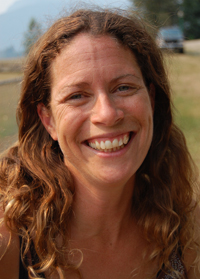

As a mother of two young children I was thrilled this past year when School District 19 and the City of Revelstoke pledged to no longer spray pesticides on local playing fields.
Now when we bike, run, or play on these fields I don’t have to worry about exposing my children to 2,4-D the most common chemical in cosmetic pesticides such as Roundup. In the past, pesticides were not widely understood but are now known to be hazardous to human health. It is like bisphenol-A, we used it until it was found out to be a plastics ingredient that is dangerous.
I believe we must go further to protect ourselves and the health of our chiidren. Dr. Bruce Lanphear at UBC’s department of pediatrics says a “decision (to ban cosmetic pesticides) makes great sense, particularly for protecting children.”
He said repeated exposure to pesticides can cause behavioural problems in children, such as ADHD. Barbara Kaminsky, CEO, of the Canadian Cancer Society for BC, Yukon, and NWT also stated that several studies have linked cosmetic pesticides and cancer, such as non-Hodgkin’s lymphoma, childhood leukemia and cancers of brain, lung and prostrate.
What parent or grandparent wouldn’t want to protect their young children from this unnecessary risk? It is now in the hands of our City Councillors. This summer in Revelstoke, they are wrestling with whether or not to move ahead with a cosmetic pesticide bylaw for both public and private land.
The idea of a total ban on cosmetic pesticides is the only reasonable option. It is justified scientifically by a risk/benefit analysis. It is justified in that what is being asked of the lawn care industry and homeowners is short-term inconvenience to adjust to alternative methods.
A ban is the only option that will significantly decrease landscape pesticide use and the only option that addresses community-wide risks. This is not a local issue, or an issue of concern only to a fringe group. It is an issue across Canada. The City of Revelstoke has the legal ability and therefore the responsibility to act.
Currently in British Columbia, more than 20 health and environmental groups have called for legislation that would prohibit the use, sale, and retail display of cosmetic pesticides. Some are still skeptical about why we need these changes. To address concerns, I offer three reasons devised by Emily-Anne Paul as to why we need a cosmetic pesticide bylaw:
First, cosmetic pesticides are inherently unnecessary. These products are used only for aesthetic purposes to beautify lawns. The results these pesticides temporarily provide are something that can be achieved through proper care and maintenance, a practice that is more sustainable and economical in the long run. In addition, these products require multiple uses to control spread and return of pests. This use not only contributes to pest resilience, it exposes users and their community to additional unnecessary risks. In a world where we are constantly exposed to carcinogens, neurotoxins, endocrine disruptors, and reproductive toxins, why would we willingly submit our families and ourselves to additional threats?
Second, we have no idea what the long-term impacts of these chemicals are. Since World War II, approximately 100,000 chemicals have been produced, of which 60,000 are still used — 25,000 in Canada. Of the 80,000 toxins in current databases, barely 10 percent have been tested for their long-term health and environmental impacts.
We need to adopt the precautionary principle and take steps to protect our health and the environment. Even if there isn’t 100 percent evidence that certain chemicals will in every situation cause cancers or neurological, endocrine, and reproductive disorders, we have no evidence they won’t. So, why are we risking exposure?
Third, and finally, we have to recognize that people deserve the right to choose what they are exposed to and to protect their health. When we talk about toxin exposure we often talk about chemical trespass, the idea that chemicals are entering and remaining in our body without our knowing, ultimately affecting our long-term health. Without legislation, it’s not as if we can just avoid our neighbour’s lawns that have been sprayed with pesticides; these products aren’t isolated on his or her private property. These chemicals don’t know property lines, they don’t care where they are released into the environment, and we don’t know where they end up.
A city pesticide bylaw that upholds the precautionary principle will help protect Revelstokians of all ages from unknown chemical exposure.
Sarah Newton is the mother of two active children



